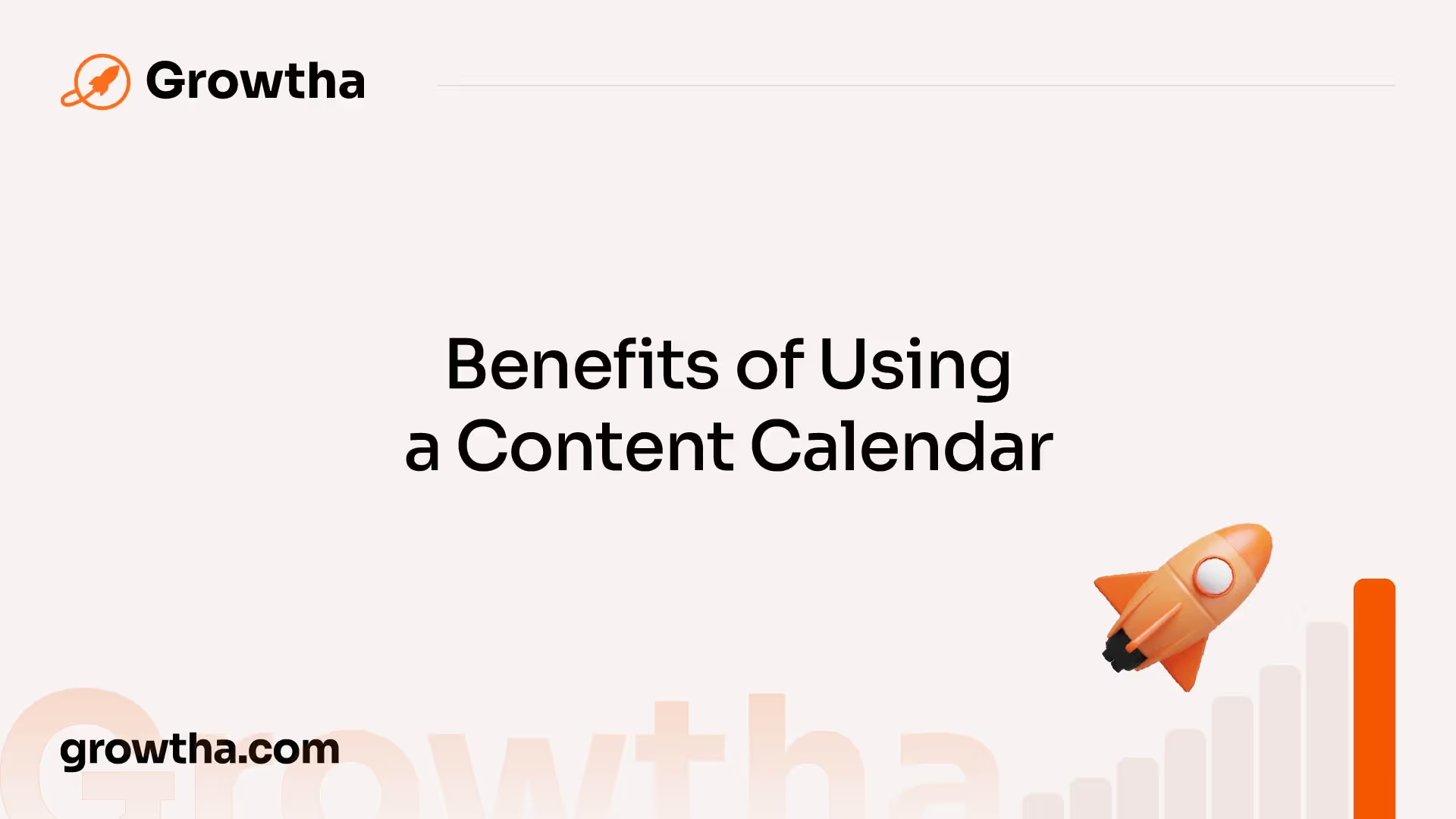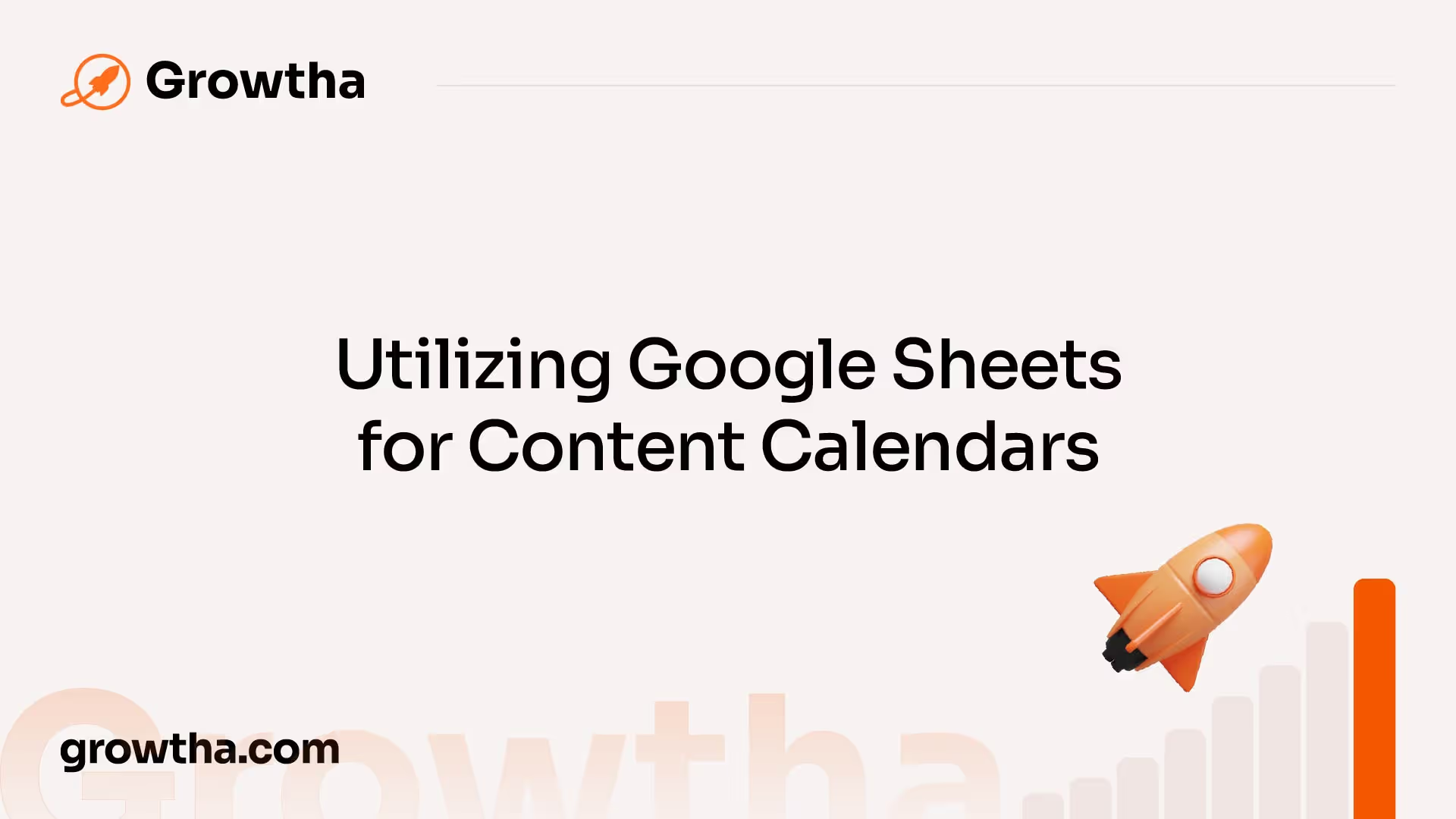How To Create a Content Calendar in Google Sheets
A content calendar serves as a central tool for content marketers, helping them coordinate marketing efforts, maintain deadlines, track progress, and visualize the entire content.


How To Create a Content Calendar in Google Sheets
Creating a Content Calendar

When it comes to content marketing, having a well-structured content calendar is essential for successful planning and execution. A content calendar serves as a central tool for content marketers, helping them coordinate marketing efforts, maintain deadlines, track progress, and visualize the entire content marketing plan in one place [1]. Let's explore the importance of content calendars and the key elements that make them effective.
Importance of Content Calendars
A content calendar is a staple in the content marketer's toolbox, providing a roadmap for content marketing strategies and campaigns. By having a clear plan in place, content marketers can ensure consistency, optimize content distribution, and align efforts with business goals. Here are some key reasons why content calendars are crucial:
- Organization and Structure: Content calendars help teams stay organized by providing a centralized view of content plans, deadlines, and assignments. This enables better collaboration and streamlines content production processes.
- Efficient Planning and Execution: With a content calendar, marketers can plan content in advance, ensuring a smooth workflow and timely delivery. It allows for better resource allocation and helps prevent last-minute rushes.
- Content Optimization: By mapping out content themes, topics, and schedules, content calendars enable marketers to strategically plan content distribution across different channels. This helps optimize content visibility and engagement.
- Consistency and Branding: A content calendar ensures consistent messaging and branding by providing an overview of planned content. It helps maintain a cohesive content strategy and ensures that all content aligns with the brand's voice and values.
Elements of a Great Content Calendar

To create an effective content calendar, certain key elements should be included. These elements provide essential information for content planning and execution. Here are the elements that every great content calendar should have:

By incorporating these elements into your content calendar, you can ensure that all necessary information is captured, facilitating a streamlined content production and distribution process [1].
Creating a content calendar is a foundational step in content marketing. It provides structure, organization, and a roadmap for successful content creation and distribution. By understanding the importance of content calendars and including the essential elements, you can effectively plan and execute your content marketing strategies.
Benefits of Using a Content Calendar

Implementing a content calendar brings various advantages to your content marketing strategy, enhancing your overall performance and driving better results. Let's explore two key benefits of using a content calendar: increased lead close rates and improved marketing performance.
Increased Lead Close Rates
According to emfluence, leads generated through a well-executed content strategy have an average close rate of 14.6%. This is significantly higher than the average close rate of outbound leads, which stands at only 1.7%. By consistently delivering valuable and relevant content to your target audience, you establish trust and credibility, increasing the likelihood of converting leads into customers.
A content calendar helps you plan and organize your content in advance, ensuring a consistent flow of engaging material that resonates with your audience. By strategically mapping out your content topics, formats, and distribution channels, you can tailor your content to different stages of the buyer's journey, nurturing leads and guiding them towards conversion. The structured approach provided by a content calendar allows you to focus on creating high-quality content that aligns with your marketing goals, ultimately leading to higher close rates.
Improved Marketing Performance
Having a well-managed content calendar brings numerous benefits that directly impact your marketing performance. As stated by Sprout Social, 64% of the most successful companies have a documented content strategy that includes a content calendar. Let's explore how a content calendar improves your marketing efforts:
- Streamlining Content Activities: A content calendar provides a centralized platform for planning, organizing, and scheduling your content, streamlining your content creation and distribution process. This allows you to maintain a consistent publishing schedule, avoid content gaps, and ensure that your content aligns with your overall marketing strategy.
- Improving Productivity: With a content calendar, you can efficiently manage your resources, assign tasks to team members, and set deadlines. This promotes better collaboration and accountability within your team, leading to increased productivity and smoother workflow.
- Easing Collaboration: A content calendar facilitates collaboration among different teams and stakeholders involved in your content marketing efforts. By providing visibility into upcoming content, deadlines, and responsibilities, it enables effective communication and coordination, leading to more cohesive and successful campaigns.
- Providing a Competitive Advantage: By planning your content in advance, you can stay ahead of your competitors. A content calendar allows you to identify content gaps, explore new topics, and leverage seasonal or industry-specific trends. This proactive approach gives you a competitive edge and positions you as a thought leader in your industry.
A well-managed content calendar saves time, brings consistency to your content marketing activities, and increases transparency and collaboration among teams and stakeholders. By using a content calendar, you can optimize your marketing efforts, maximize your resources, and achieve better results in the ever-evolving landscape of content marketing.
Planning Your Content Calendar

To create an effective content calendar, proper planning is essential. This section will cover two crucial aspects of content calendar planning: gathering key information and organizing the calendar structure.
Gathering Key Information
Before diving into creating a content calendar, it's important to gather key information from your content marketing strategy. This information forms the foundation of your calendar and helps ensure that your content aligns with your overall goals and objectives. Some key pieces of information to consider include:
- Content Marketing Strategy: Review your content marketing strategy to understand your target audience, content goals, and messaging. This will guide the type of content you plan to create and the topics you'll cover.
- Content Channels: Identify the channels you plan to use to distribute your content, such as your website, blog, social media platforms, email newsletters, or video channels. Each channel may have different requirements and considerations.
- Content Themes: Determine the overarching themes or topics you want to focus on during specific periods. This helps create a cohesive content strategy and ensures that your calendar covers a diverse range of subjects.
- Analytics and Insights: Analyze data from previous content campaigns, website analytics, or social media insights to understand what has resonated with your audience. Use this information to inform your content decisions and optimize your calendar.
By gathering this key information, you'll have a solid understanding of your content goals, target audience, and channels, enabling you to create a calendar that aligns with your overall strategy.
Organizing the Calendar Structure
Once you have gathered the necessary information, it's time to organize the structure of your content calendar. Google Sheets is a popular choice for creating content calendars due to its versatility and accessibility. Here's how you can organize your calendar structure effectively:
- Choose a Timeframe: Decide whether you want to plan your content on a daily, weekly, monthly, or quarterly basis. This will depend on your content production capacity and the level of detail you require.
- Create Columns: Use the columns in your Google Sheets to represent different elements of your content calendar. Common columns include dates, content titles, assigned team members, content formats, and status (e.g., in progress, published, or scheduled).
- Color Coding: Utilize color coding to visually distinguish different types of content, such as blog posts, social media updates, or videos. This makes it easier to scan the calendar and identify content at a glance.
- Include Additional Tabs: Consider adding separate tabs within the Google Sheets document for different content channels or specific campaigns. This allows for more focused planning and organization within the same document.
- Collaboration and Accessibility: Share your Google Sheets calendar with relevant team members to enable collaboration. This ensures everyone has access to the calendar and can contribute or make updates in real-time, keeping everyone organized and informed.
By organizing your content calendar in Google Sheets, you can take advantage of its visual appeal, navigation features, collaboration capabilities, and accessibility from anywhere with an internet connection [2]. Additionally, Google Sheets is a cost-effective option as it is free to use, making it suitable for small businesses or individuals with tight budgets [2].
With the key information gathered and the calendar structure organized, you are well-equipped to create an effective content calendar that will keep your content strategy on track and help you achieve your marketing goals.
Utilizing Google Sheets for Content Calendars

When it comes to creating and managing content calendars, Google Sheets proves to be a valuable tool. It offers a range of features that enhance the visual appeal, navigation, collaboration, and accessibility of your content calendar.
Visual Appeal and Navigation
Google Sheets provides various formatting and design options to make your calendars visually appealing and easy to navigate. You can choose different colors, fonts, and styles to align with your team's branding or reflect a unique style. This allows you to create a calendar that is not only functional but also visually engaging [2].
With the ability to customize the appearance of your content calendar, you can easily highlight important dates, categorize content types, or color-code tasks. These visual cues make it easier for your team to understand and interpret the calendar at a glance. Additionally, you can utilize conditional formatting to automatically apply specific formatting styles based on predetermined criteria, further enhancing the visual appeal and organization of your calendar.
Collaboration and Accessibility
One of the key advantages of using Google Sheets for content calendars is the ease of collaboration and accessibility it provides. You can easily share your content calendar with team members, granting them real-time access for updates and contributions. This ensures that everyone is on the same page and can stay organized and informed [2].
Google Sheets also allows for offline access, enabling you to work on your content calendar even without an internet connection. Once you regain connectivity, your changes will automatically sync, ensuring that you and your team are always up to date.
In addition to collaboration, Google Sheets integrates seamlessly with other Google tools such as Google Calendar and Google Drive. This integration enables you to sync your content calendar with Google Calendar, allowing you to view and manage your content schedule alongside your other appointments and events. It also facilitates easy file storage and sharing through Google Drive, providing a centralized location for all your content-related documents and assets.
Furthermore, Google Sheets is a cost-effective option for creating content calendars as it is free to use. This makes it particularly beneficial for small businesses or individuals who may not have the budget for a dedicated calendar tool. With Google Sheets, you can create and maintain a professional content calendar without incurring any additional expenses [2].
By utilizing Google Sheets for your content calendars, you can take advantage of its visual customization options, streamlined collaboration, and accessibility features. This allows you to create a well-organized and visually appealing calendar that promotes effective content planning and collaboration within your team.
Tips for Effective Content Calendars
To create an effective content calendar in Google Sheets, there are a few key tips to keep in mind. These tips will help you maximize the usefulness of your content calendar and streamline your content planning process.
Data Validation and Standardization
When working with a content calendar, it's important to ensure accurate data entry and maintain consistency throughout. Google Sheets provides the functionality to implement data validation rules, which can help prevent errors and enforce standardization. For example, you can set a data validation rule in the Date column to warn users when they enter an invalid date. Dropdown menus can also be used in columns to standardize inputs such as Type of Content, Assignee, and Status fields. This helps maintain uniformity and facilitates easier analysis of the content calendar [3].
Free Content Calendar Templates
Creating a content calendar from scratch can be time-consuming, especially if you're not familiar with the process. Thankfully, Google Sheets offers a variety of free content calendar templates to help you get started. These templates cater to different purposes, such as editorial calendars, social media content calendars, and blog content calendars. Using these templates allows you to save time, manage campaigns effectively, share content with other teams, and track content publication status. It's worth exploring the available templates to find one that suits your specific needs.
Here is an example of a content calendar template in Google Sheets:

Table example from a content calendar template
By utilizing data validation and standardization techniques and leveraging pre-made content calendar templates, you can enhance the effectiveness of your content planning process and ensure a more organized and efficient workflow in Google Sheets.
Advanced Techniques with Google Sheets
To take your content calendar in Google Sheets to the next level, you can leverage advanced techniques that enhance functionality and streamline your workflow. Two key aspects to explore are syncing with other tools and implementing custom automation and integration.
Syncing with Other Tools
Google Sheets seamlessly integrates with other Google tools, such as Google Calendar and Google Drive, allowing users to sync calendars, link to, and organize relevant files and documents within the spreadsheet, keeping everything in one centralized location [2]. This integration enables you to have a comprehensive view of your content strategy, deadlines, and associated materials.
Additionally, tools like Unito provide a solution to push data from a Google Sheets content calendar to other platforms like Asana, Trello, Notion, and Airtable. This allows for a more visual representation of the calendar and seamless content collaboration. With Unito, you can automatically sync rows from a Google Sheets content calendar to other tools in your stack, enhancing workflow management and collaboration [3].
Custom Automation and Integration
With Google Sheets, you have the flexibility to implement custom automation and integration to further streamline your content calendar management. By utilizing formulas, scripts, and add-ons, you can automate repetitive tasks, save time, and reduce the chance of errors.
For example, you can use formulas to automatically calculate dates, track progress, or generate reports based on the data in your content calendar. Conditional formatting can be applied to highlight important milestones or approaching deadlines.
Moreover, Google Sheets offers various add-ons that can enhance the functionality of your content calendar. These add-ons provide additional features and capabilities, such as project management tools, social media scheduling, and data analysis.
By exploring the advanced techniques available in Google Sheets, you can optimize your content calendar and improve overall efficiency. Whether it's syncing with other tools or implementing custom automation, these techniques allow for seamless collaboration, enhanced visualization, and streamlined workflows. Take advantage of the power of Google Sheets to revolutionize your content planning and execution process.
References
[1]: https://emfluence.com/blog/7-elements-effective-content-calendar
[2]: https://blog.hubspot.com/marketing/make-calendar-google-sheets







